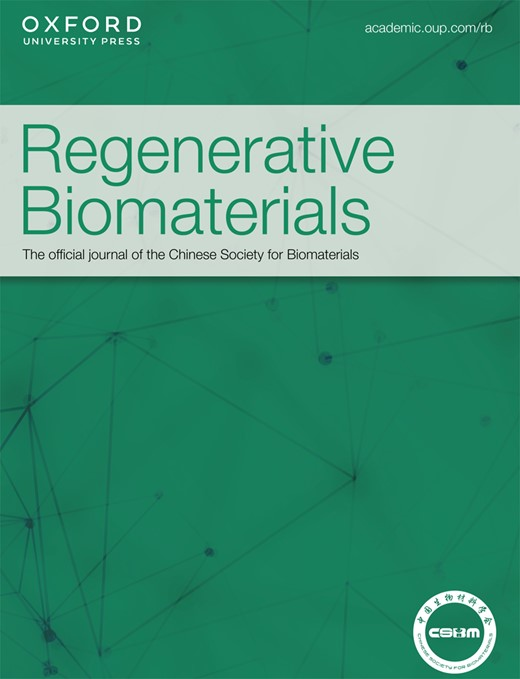装载人参皂苷 Rg3 脂质体的可溶解微针:治疗脱发的透皮给药方法
IF 5.6
1区 医学
Q1 MATERIALS SCIENCE, BIOMATERIALS
引用次数: 0
摘要
皮肤角质层(SC)的屏障功能会干扰局部治疗的吸收,降低药物对脱发的治疗效果。微针(MNs)可以穿透皮肤屏障,将药物输送到真皮层。此外,微针还能对皮肤产生机械刺激,从而促进毛发生长。因此,我们设计了一种由透明质酸(HA)和小叶紫檀多糖(BSP)制成的绿色可溶解复合微针,用于包裹不含胆固醇的人参皂苷 Rg3 脂质体(Rg3-LPs),以避免胆固醇代谢产生的睾酮抑制毛发再生,并最大限度地减少皮肤屏障对脂质体吸收的影响。HA 和 BSP 可增强 Rg3-MNs 的机械强度,确保脂质体被输送到毛囊区(HF),同时将对皮肤的刺激降至最低,并保证细胞的相容性。此外,HA 还能增加毛发密度,更有利于毛发再生。在毛囊性脱发(TE)和睾酮诱导的雄激素性脱发(AGA)动物中,Rg3-MNs 在低频治疗中取得了与米诺地尔相当的疗效,而且再生毛发的质量更高。此外,定量表征和转录组测序结果表明,Rg3-MNs 通过促进 Wnt3a 和 Wnt10b 基因的表达,激活 Wnt/β-catenin 通路,从而促进毛发再生。因此,Rg3-MNs 在治疗脱发方面具有广阔的前景。本文章由计算机程序翻译,如有差异,请以英文原文为准。
Dissolvable Microneedles Loaded Ginsenoside Rg3 liposome: A Transdermal Delivery Approach for Alopecia Treatment
The skin stratum corneum (SC) barrier function will interfere with the absorption of topical treatment and reduce the drug's therapeutic effect on alopecia. Microneedles (MNs) can penetrate the skin barrier and deliver drugs to the dermis. Furthermore, MNs can mechanically stimulate the skin, which promotes hair growth. Thus, we designed a green and dissolvable composite microneedle made of hyaluronic acid (HA) and Bletilla striata polysaccharide (BSP) to encapsulate cholesterol-free ginsenoside Rg3 liposomes (Rg3-LPs) to avoid cholesterol metabolism-producing testosterone to inhibit hair regeneration and minimize the effect of the SC barrier on liposomes absorption. HA and BSP can enhance the mechanical strength of Rg3-MNs to ensure the transport of liposomes to the hair follicle region (HF) while causing minimal skin irritation and guaranteeing cell compatibility. In addition, HA increased hair density and was more conducive to hair regeneration. In telogen effluvium (TE) and testosterone-induced androgenetic alopecia (AGA) animals, Rg3-MNs achieved comparable efficacy to minoxidil with low-frequency treatment, and the quality of regenerated hair was higher. Furthermore, quantitative characterization and transcriptome sequencing results showed that Rg3-MNs promoted hair regeneration by promoting the expression of Wnt3a and Wnt10b genes, activating the Wnt/β-catenin pathway. Therefore, Rg3-MNs present broad prospects in the treatment of alopecia.
求助全文
通过发布文献求助,成功后即可免费获取论文全文。
去求助
来源期刊

Regenerative Biomaterials
Materials Science-Biomaterials
CiteScore
7.90
自引率
16.40%
发文量
92
审稿时长
10 weeks
期刊介绍:
Regenerative Biomaterials is an international, interdisciplinary, peer-reviewed journal publishing the latest advances in biomaterials and regenerative medicine. The journal provides a forum for the publication of original research papers, reviews, clinical case reports, and commentaries on the topics relevant to the development of advanced regenerative biomaterials concerning novel regenerative technologies and therapeutic approaches for the regeneration and repair of damaged tissues and organs. The interactions of biomaterials with cells and tissue, especially with stem cells, will be of particular focus.
 求助内容:
求助内容: 应助结果提醒方式:
应助结果提醒方式:


